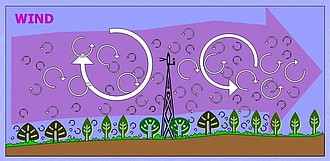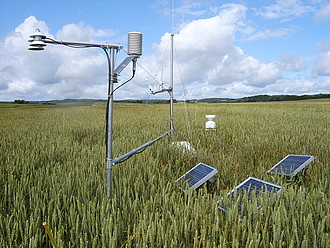Meteorological Measuring Stations with Eddy Covariance Systems
The eddy covariance technique allows the direct measurement of energy, water, and trace gace fluxes between the land surface and the atmospheric boundary layer. The method is based on the assumption that vertical fluxes are due to spatially limited turbulences, so called eddies.
During the growing season, energy, water and trace gas fluxes are continuously measured on three fields with typical crop rotation in each of the two study regions. To this end, eddy covariance weather stations recording fluxes of sensible and latent heat, CO2, wind velocity, air temperature, net radiation, precipitation, and soil heat flux at high temporal resolution were installed on each field. In addition, soil temperature, soil moisture contents, and matrix potential in five different soil depths (5, 15, 30, 45, 75 cm) are measured.
The weather stations purchased from Campbell Scientific Co. consist of 3 - 4.5 m high towers, to which an Open Path H2O/CO2 infrared gas analyzer and a 3D sonic anemometer as well as radiation, temperature and moisture sensors are fixed. The stations are also equipped with a precipitation gauge, soil sensors, and a data logger and are provided with energy by solar panels.


